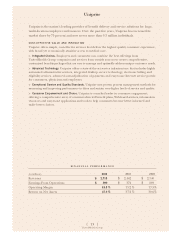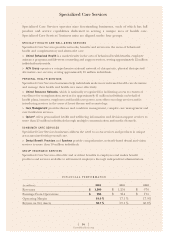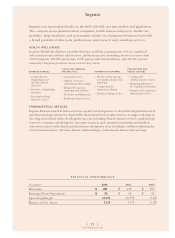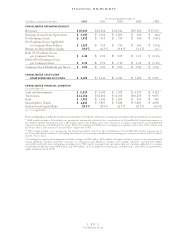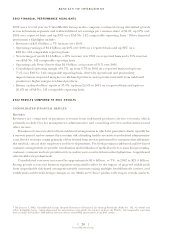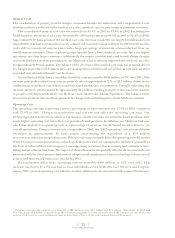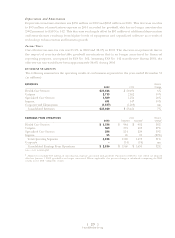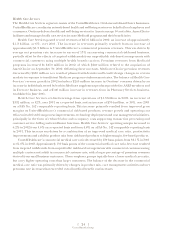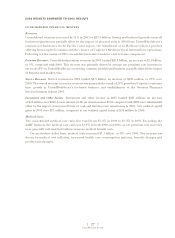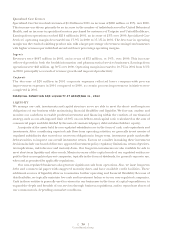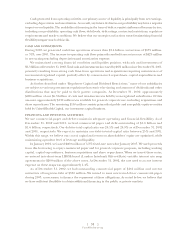United Healthcare 2002 Annual Report Download - page 23
Download and view the complete annual report
Please find page 23 of the 2002 United Healthcare annual report below. You can navigate through the pages in the report by either clicking on the pages listed below, or by using the keyword search tool below to find specific information within the annual report.
{ 22 }
UnitedHealth Group
Medical Costs
The combination of pricing, benefit designs, consumer health care utilization and comprehensive care
facilitation efforts is reflected in the medical care ratio (medical costs as a percentage of premium revenues).
The consolidated medical care ratio decreased from 85.3% in 2001 to 83.0% in 2002. Excluding the
AARP business,1the medical care ratio decreased by 250 basis points from 83.9% in 2001 to 81.4% in 2002.
Approximately 90 basis points of the medical care ratio decrease resulted from targeted withdrawals from
unprofitable risk-based arrangements with commercial customers using multiple health benefit carriers
and a shift in commercial customer mix, with a larger percentage of premium revenues derived from our
small business customers. These employer groups typically have a lower medical care ratio, but carry higher
operating costs than larger customers. Additionally, the impact of withdrawals and benefit design changes
in certain Medicare markets pertaining to our Medicare+Choice offering improved the medical care ratio
by approximately 90 basis points. The balance of the decrease in the medical care ratio was primarily driven
by changes in product and business mix, care management activities and net premium rate increases that
exceeded overall medical benefit cost increases.
On an absolute dollar basis, consolidated medical costs increased by $548 million, or 3%, over 2001. This
increase principally resulted from a rise in medical costs of approximately 12%, or $2.1 billion, driven by the
combination of medical cost inflation and increased health care consumption. Partially offsetting this
increase, medical costs decreased by approximately $1.4 billion resulting from net reductions in the number
of people receiving benefits under our Medicare and commercial risk-based products. The balance of the
decrease in medical costs was driven primarily by changes in benefit designs in certain Medicare markets.
Operating Costs
The operating cost ratio (operating costs as a percentage of total revenues) was 17.5% in 2002, compared
with 17.0% in 2001. Changes in productivity and revenue mix affect the operating cost ratio. Our
fee-based products and services, which are growing at a faster rate than our premium-based products, have
much higher operating cost ratios than our premium-based products. In addition, our Medicare business,
which has relatively low operating costs as a percentage of revenues, has decreased in size relative to our
overall operations. Using a revenue mix comparable to 2001, the 2002 operating cost ratio would have
decreased by approximately 20 basis points, representing the equivalent of a $50 million
year-over-year reduction in operating costs. This decrease was principally driven by operating cost efficiencies
derived from process improvements, technology deployment and cost management initiatives, primarily in
the form of reduced labor and occupancy costs supporting our transaction processing and customer service,
billing and enrollment functions. The impact of these efficiencies was partially offset by the incremental costs
associated with the development, deployment, adoption and maintenance of new technology releases as well
as increased business self-insurance costs during 2002.
On an absolute dollar basis, operating costs increased by $408 million, or 10%, over 2001. This
increase was driven by a 7% increase in total individuals served by Health Care Services and Uniprise
during 2002, general operating cost inflation and the additional costs associated with acquired businesses.
1Premium revenues and medical costs from the AARP business were $3.7 billion and $3.4 billion, respectively, in 2002 and
$3.6 billion and $3.3 billion, respectively, in 2001. Underwriting gains or losses related to the AARP business are recorded as an
increase or decrease to a rate stabilization fund as described in Note 4 to the Consolidated Financial Statements.



